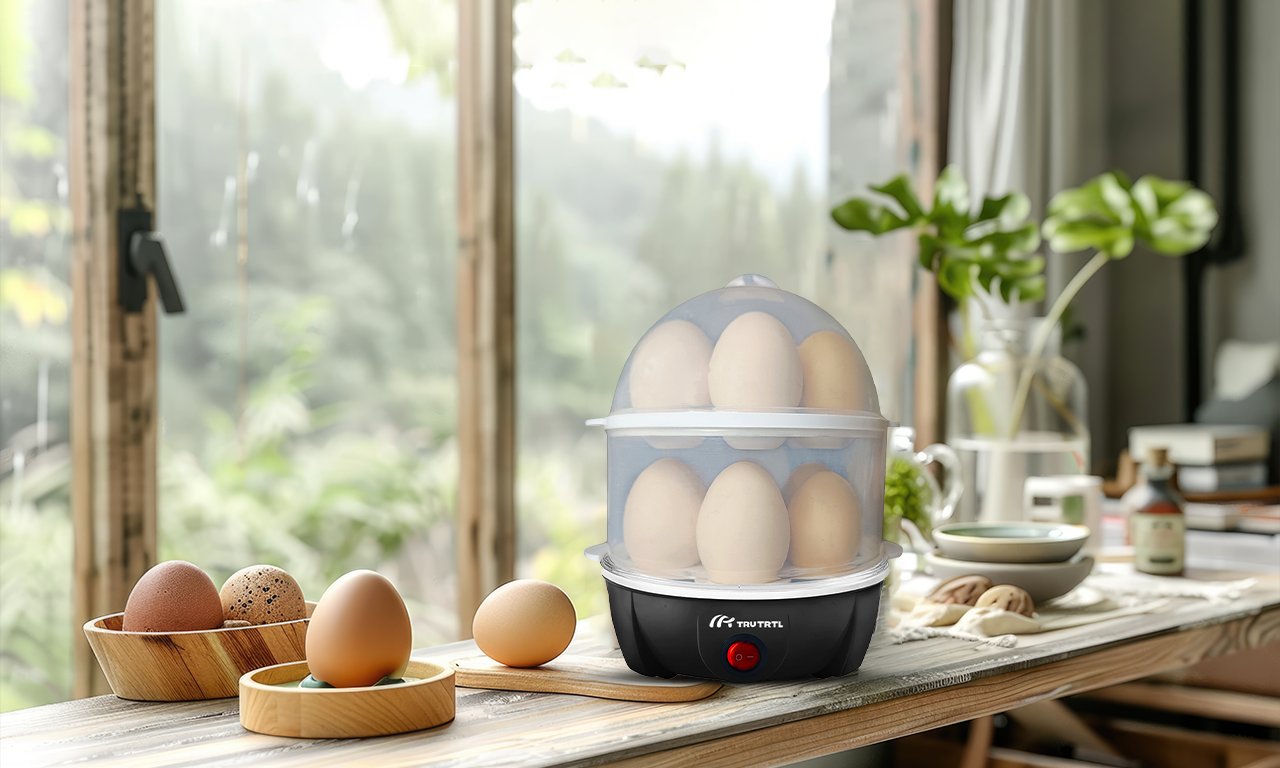Boiled eggs remain a favourite breakfast for many—whether you’re a gym-goer, a busy professional, or a health-conscious family. But the big question is: should you use an electric egg boiler or stick with the old‑school stovetop method? Which wins on speed, safety, and cost-effectiveness?
In this article, we'll explore both options in detail, helping you make an informed decision—whether you're eyeing an egg boiler under ₹500 or reevaluating your current approach.
What Does an Egg Boiler Do?
An egg boiler machine is a compact countertop device that cooks eggs using steam. Simply add a small amount of water to the stainless-steel heating plate, place your eggs in the tray, and let the machine work its magic. Most models include auto shut‑off, audible alerts, and even optional omelet trays.
Brands like truTRTL offer reliable, budget-friendly options. Check them out below:
- Facebook | Instagram | YouTube
How Does Traditional Boiling Work?
This method requires eggs to be submerged in a pot of water and boiled on a gas stove or induction cooktop—a practice familiar in many Indian homes. Although effective, it demands close attention, can waste water, and results are often inconsistent.
Head-to-Head: Egg Boiler vs Traditional Boiling
Here’s a breakdown of how both methods compare:
Speed
- Egg Boiler: 6–12 minutes for 5–7 eggs; hands-free thanks to auto shut‑off
- Stovetop: 10–15 minutes (water boil + timer); requires supervision
Winner: Egg Boiler — quicker and more consistent
Energy Efficiency & Water Use
|
Method |
Power/Heat |
Water Usage |
Waste |
|
Egg Boiler |
360–400W electric |
50–100 ml |
Minimal |
|
Traditional Boil |
Gas or Induction |
500–800 ml |
High (evaporation) |
Winner: Egg Boiler — saves both power and water
Cost Comparison
- Egg Boiler: ₹400–₹1,500 purchase cost + low energy use
- Stovetop: No special purchase (if you already have cookware), but higher utility costs
Verdict: Egg boilers are a smart investment for frequent users—especially models under ₹500, like those from truTRTL.
🛠 Ease of Use & Cleanup
- Egg Boiler: Simple plug‑and‑play, auto shut‑off minimizes risk, compact, and easy to clean (just wipe the steam plate)
- Traditional: Manual boiling, risk of overcooking, and requires cleaning pots and utensils
Winner: Egg Boiler — cleaner and safer
Who Should Use Each Method?
Egg boilers are perfect for:
- Students in hostels
- Working professionals
- Fitness enthusiasts
- Travelers and minimalists
Traditional boiling is better for:
- Cooking large batches
- Situations without electricity or budget constraints
- Anyone comfortable supervising a stove
Top Egg Boiler Picks Under ₹500
Here are reliable, budget-friendly models worth considering:
- truTRTL Electric Egg Boiler
- Capacity: 7 eggs
- Features: Steel heating plate, auto shut‑off
- Price: ₹499
- KWT Mini Egg Boiler
- Capacity: 6 eggs
- Features: Compact, stainless plate
- Price: ~₹450 (during discounts)
- Goodscity Basic Egg Cooker
- Capacity: 6 eggs
- Price: ₹399–₹450
Tips for Perfectly Boiled Eggs
- Prick eggs with the pin provided to prevent cracking
- Use the measuring cup for precise water levels
- Clean the heating plate regularly to prevent scaling
- Water amount matters:
- Soft: ~25 ml
- Medium: ~50 ml
- Hard: ~75–100 ml
Considerations Before Buying an Egg Boiler
- Typically limited to cooking 6–7 eggs per batch
- Not suitable for large households
- Budget models may lack auto shut‑off
- Needs power (not usable during outages)
Where to Buy Online
Check these platforms for great deals:
- Amazon India – frequent sales and cashbacks
- Flipkart – combo deals and bank offers
- truTRTL Social Media – Facebook, Instagram, YouTube for product updates and tips
Final Thoughts
If you value speed, efficiency, safety, and consistency, an electric egg boiler is a solid investment—especially when you can buy a reliable option under ₹500. While traditional boiling has its place, the convenience of egg boilers makes them perfect for busy lives.
Follow truTRTL for More!



Share:
Egg Boiler Under ₹500: Affordable Options That Actually Work
Electric Grill Sandwich Maker vs. Manual Sandwich Press: Which is Better?